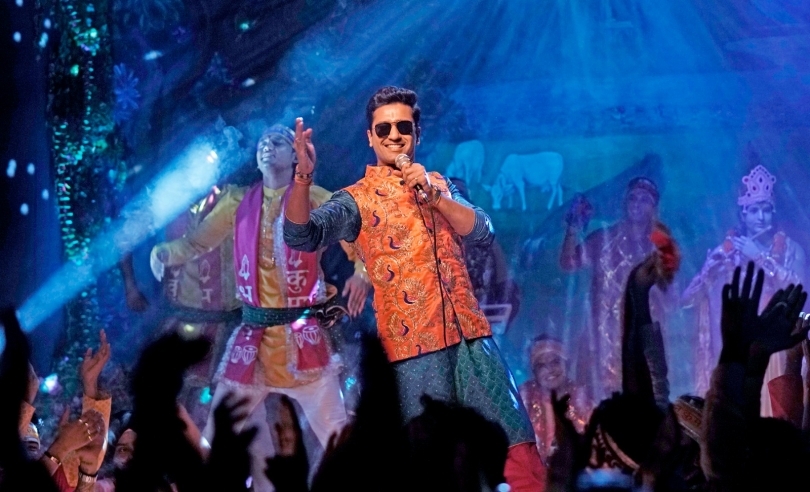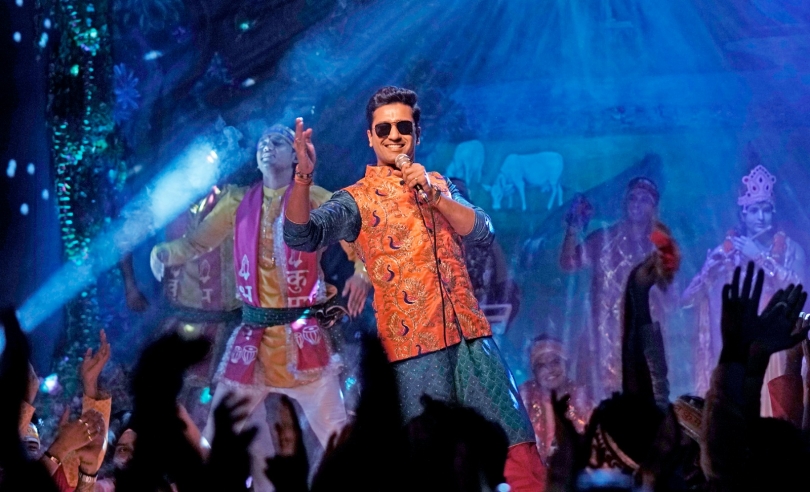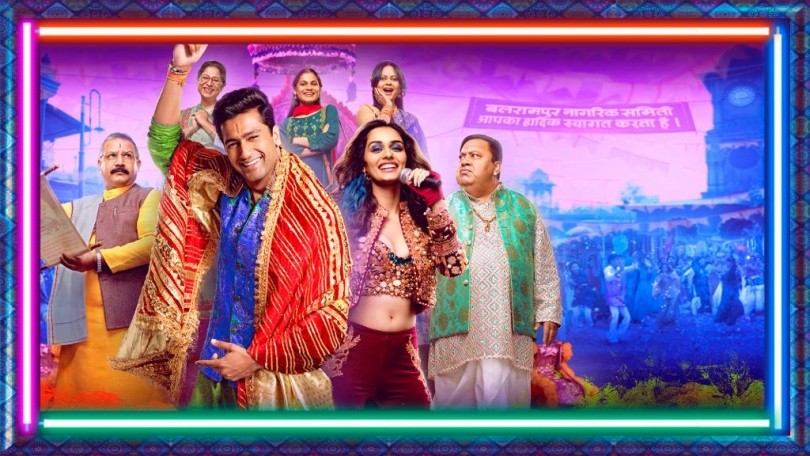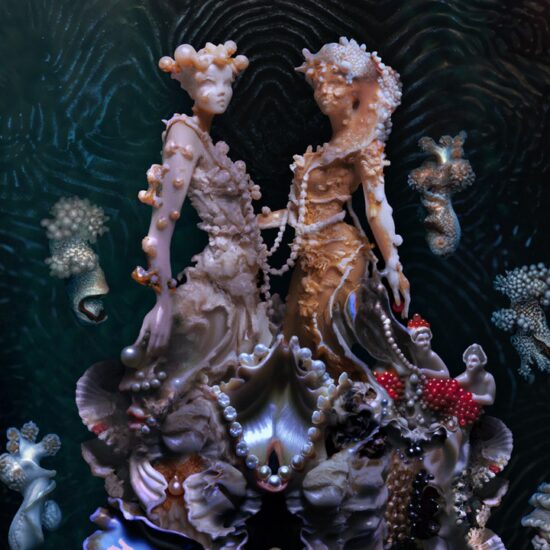
The Great Indian Family, Review: Pandit pop’s bhajan singing son is a Muslim
What a roundabout route it has taken to emerge as The Great Indian Family! It began with the 2010 British film The Infidel, starring Omid Djalili (the D is silent), directed by Josh Appignanesi and a cast that included South Asian sounding names like Archie Panjabi, Saamiya Nasir, James Krishna Floyd, Nabi Nasir, Mina Anwar, Amit Shah, Uzma, Ravin J. Ganatra and Niraj Naik. Five years later, we had an Indian adaptation, an official one, called Dharam Sankat Mein (Religion in Crisis, 2015). This was a comedy drama film, directed by cinematographer Fuwad Khan, in his debut. The film featured Paresh Rawal, Annu Kapoor and Naseeruddin Shah in pivotal roles, and told the story of an ordinary Hindu man who discovers that he was originally born a Muslim. Cut to 2023. Studio major YashRaj Films produces and releases The Great Indian Family (TGIF), based on the same subject, but with several twists of its own. It is largely the handiwork of the man who made three Dhoom films for the same banner, Vijay Krishna Acharya. However, this time around, we might not have as great a member as many of its predecessors joining the great YRF Family Super-Hit List.
Narrated largely through a Voice-Over, the film is about a Pandit (Hindu priest) family, the Tripathis, living in Balrampur. They are highly regarded and invited to perform the religious rites of most locals, rites usually related to birth, marriage and death. Another Pandit, by name Mishra, is their arch-enemy and has the pie of ceremonial fees in his eye. He is waiting to push aside Siya Ram Tripathi and, along with his son, TD (Tulsidas), fill in the vacuum. Tripathi’s son Ved Vyas, meanwhile, has grown-up to become a pop bhajan singer. Bhajan, a form of devotional singing, is usually slow and mellow. Not for Ved. On one occasion, Ved Vyas arrives on the scene and tells the DJ to stop playing Pankaj Udhas (popular ghazal and bhajan singer) bhajans and launches his own extravaganza. The audience swoons. No wonder he is known as Bhajan Kumar. A dull student in his schooldays, he now hangs out with a couple of louts, one a local and another who is a Bengali by birth.
An event of humungous proportions is coming up: a wedding in the Malpani family. The Malpanis, like many Balrampurians, are devoted followers of Pandit Siya Ram Tripathi. Right from matching the horoscopes of the couple, to fixing a date for the wedding to performing all the rituals, the Tripathis stand to make a decent chunk of money. But it so happens that shortly before the marriage, Siya Ram is due to go on an annual pilgrimage to the Himalayas and meditate there for 10 days. There is no real problem, because the dates of the various ceremonies do not fall in the pilgrimage period. And Balak Ram is quite capable of standing in, should the need arise. Though he is a bit concerned, Tripathi goes ahead with his plans. While he is away, a letter arrives, addressed to Siya Ram. Since he would be away for several days more, the family opens the letter and Ved Vyas reads it aloud. The contents sweep the ground away from the family’s feet. According to the sender, a one-time Ward Boy at a hospital, the boy raised by the Tripathi family, born in 1992, was the child of Muslim parents. He goes on to give details to prove his statement. Ved Vyas Tripathi, alias Bhajan Kumar, a Muslim? Strong repercussions follow, some imaginable, others unimaginable.
Giving writing credit in this case is a knotty affair, but the present version is written and directed by Vijay Krishna Acharya. ‘Written’, here, would mean story, screenplay and dialogue, with only some elements of the story borrowed from Dharam Sankat Mein. When it comes to religious affairs and the confrontation between Tripathi and Mishra, Acharya is in his element. The scene where Tripathi suddenly feels uneasy in the middle of his meditation hints at telepathy, but can be attributed to belief. Turning bhajan into a pop form may sound original, but there have been beat masses in churches all over the world, including India, at least since the 1970s. With the entry of the female lead, Acharya begins to lose his grip over the narrative. When the great Indian family, which includes Ved’s twin sister, uncle and aunt, starts getting to grips with the profound discovery and its ramifications, it seems nobody knows what to do, including the writer. Ved asking his new-found Muslim friends to show him how Muslims eat borders on the ludicrous, especially when he notices that one of them is eating with his left hand, and suggests that Muslims must be eating that way. In one scene, Ved says that he is a Muslim, whose birth was possible due to the efforts of a Parsee, Dr. Irani, he was raised by a Hindu, is in love with a Sikh woman (Jasmeet) and has just visited the church. Secularism achieved. Communal harmony attained. There is really no need to make a 112-minute film on the subject. A 1.12-minute film would convey the message loud and clear. The trick about manipulating DNA tests, if original, is brilliant.
TGIF (not Thank God It’s Friday) opens with a man walking with a swagger. He is dressed in a stage costume, and the camera follows him from the back. You could be forgiven for thinking this is Karan Johar in a special appearance, but for the 1.83cm height that Vicky Kaushal commands. He goes up on stage and holds sway as Bhajan Kumar. After the performance, a group of attractive girls heads towards him, seeking his autograph, only to bypass him and head farther, towards a more venerated figure. In their first encounter, Jasmeet behaves in a highly illogical manner towards Ved. It seems highly convenient that a Muslim family is like a foster family to Jasmeet, who is Sikh. The three friends quibbling over who saw Jasmeet first and who, therefore, should have the right of passage, is slice-of-life. Childhood and school scenes are funny and irreverent, but in a childish kind of way. Almost the entire track is put across by way of Voice-Over, which, to me, did not sound that of Vicky Kaushal. And it should have been Vicky Kaushal. I believe Hospital Ward Boys do not issue birth certificates. And then, why should a Ward Boy keep sending annual letters to Siya Ram, on the same issue, though he never replies? And why for the last ten years only? Practicing democracy at home, through a huge ballot box and just six voters, on every major issue, elicits a chuckle, which, I am sure, the writer did not foresee.

There is little doubt that Vicky Kaushal has oodles and oodles of talent. It has yet to achieve a 360° status, though. Here, he has been tested, and found lacking in some parts. There are occasions when he gives you the impression that he is lost. It is not a case of perfect casting, as he does not blend with the milieu. It’s a performance on par, but you expect more from Vicky. Manushi Chhillar returns to the YRF fold after her debut in Prithviraj Chauhan last year. She is bubbly and beautiful, with very few scenes of her own.
The press was invited to attend the launch of the trailer and an interaction with the team. Prithviraj Chauhan was the last Hindu ruler of Delhi before the foreign conquest of Hindustan for nearly 565 years (1192-1757). The film chronicled how Prithviraj fought and killed many of the invaders, who happened to be Muslims, from neighbouring countries. It was very clear that the film was made to cater to anti-Muslim sentiment. They even had a retinue of bouncers with slogans painted on their T-shirts, standing behind the media, shouting Hindu war cries throughout the event. And then here comes a film that holds an olive branch to fanatic communal forces.
To put it in context, producer Aditya Chopra’s father, late Yash Chopra’s first two films as director were Dhool ka Phool (1959) and Dharamputra (1961), both against religious bigotry and championing secularism. In 1961, late Ali Raza Rizvi, husband of actress Nimmi, who later directed Pran Jaye Par Vachan Na Jaye, wrote a script called Ram Mohammed D’Souza. This was about a child who is brought up by three individuals with different faiths. Since he could not get backers for filming it, he published it as a book. Come 1969, and along came the South film Nannha Farishta, with exactly the same theme. Writing credits were attributed to Inder Raj Anand and Thuraiyoor K. Moorthy.

Manoj Pahwa as Balak Ram, Siya Ram’s brother, is a powerhouse. Though I have some reservations about him fitting into the family, that does not detract from his effort. Now here is one that had me captivated: Kumud Mishra as Pandit Siya Ram Tripathi. In a most unlike Kumud Mishra portrayal, he had us rivetted. Like Manoj Pahwa, Yashpal Sharma as Pandit Jagannath Mishra seems a bit like an outsider. There is little doubt about his talent, though. Sadiya Siddiqui as Hema is a veteran and carries off serious roles particularly well. Aasif Khan as Tulsidas Mishra is part caricature, but why blame him? The role was written that way. We also spotted Alka Amin as Sushila Kumari, Srishti Dixit as Gunja, Bhuvan Arora as Bhaata, Ashutosh Ujjwal as Sarveshwar, Bharti Perwani and Sougata Ghosh (Bengali?).
Starting on a lighter note, Nakash Aziz sings ‘Kanhaiya Twitter pe aa jaa’. Should resonate with generation z+. The other three songs are serviceable too, cornering over 15 minutes of time. All songs are composed by Pritam. The point worth noting is that these songs are all lip-sync, which is becoming a rarity in the post 2010 era. Cinematography by Ayananka Bose uses many two-shots and over-the-shoulder shots, as well as playing with foreground and background focus. Editor Charu Shree Roy is well in control, and the films is of a standard length. Background score is by Kingshuk Chakravarty (Suraj Pe Mangal Bhari). The sound department revels in keeping the needle in the red zone, something the audience could have done well without.
The Great Indian Family has a title that is misleading and a narrative that is centrifugal. It deals with very, very serious issues, and is unable to do full justice to each aspect of the complex conundrum that is religion/religiosity in the India of 2023.
Rating: **
Trailer: https://youtu.be/jxRgnlvep94














